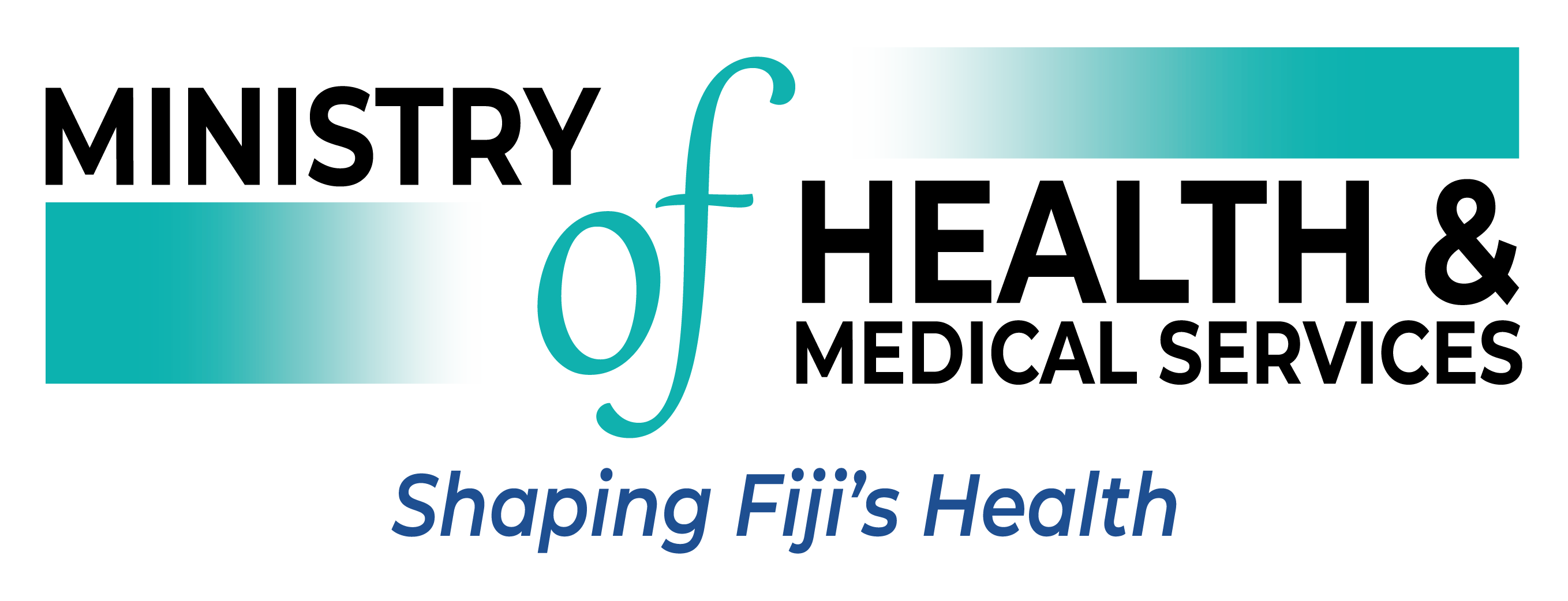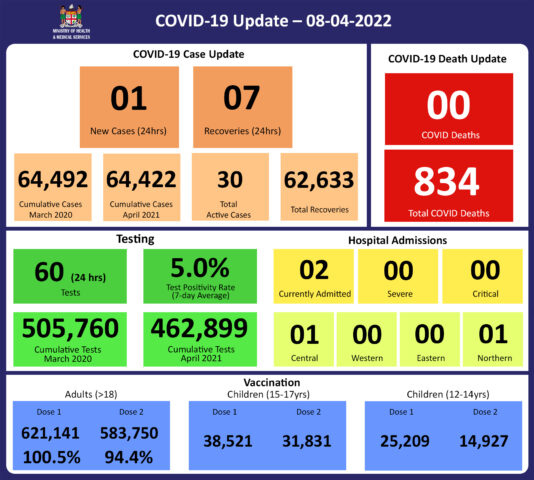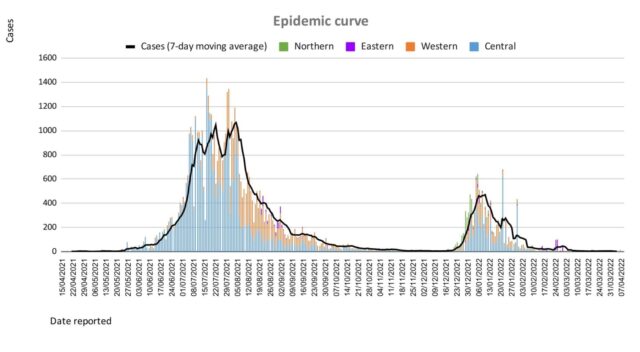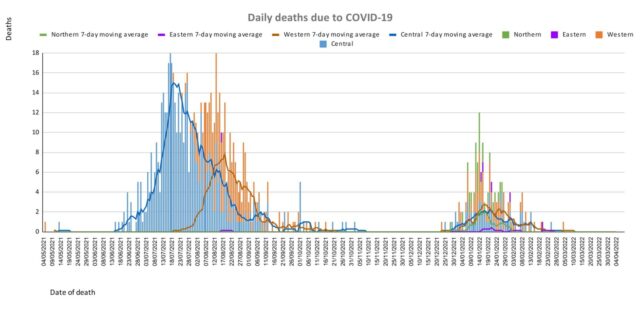COVID-19 Update 08-04-2022
COVID-19 Update
Friday 08th April
Public Advisory
Engaging COVID safety without mandates or quarantine
As of the 7th of April, all quarantine measures at the border are now lifted. This includes the 10-day border quarantine for travellers from non-travel partner countries, and the 3-day hotel stay for travellers from travel partner countries. The travel partner country system is also being discontinued. Our border protection will be mediated by the fact that travellers are vaccinated, have a negative pre-departure test and will be tested in-country by a rapid antigen test. Travellers 12 years and above must produce proof of a pre-booked and pre-paid rapid antigen test, to be administered in Fiji after 48 hours, but before 72 hours of arrival in Fiji. Booking for tests can be made through this link: https://entrytestfiji.com. There will be exemptions for those with fit to fly certificates. Failure to comply with arrival testing once in Fiji will result in a spot fine of $1000.
As such the onus is now, more firmly on every individual to keep themselves safe with the measures that are available and known to be effective. We leave it to you to assess your own level of risk and decide to continue to take measures such as masking and social distancing. For example, we know wearing a mask in public will lower your risk of getting infected, and it is now an individual choice that is recommended by the Ministry. If you are at higher risk of severe disease should you get infected with COVID-19, we strongly recommend that you continue to wear a mask in public, particularly in crowded indoor spaces.
The lifting of masking and other mandates, and easing of travel restrictions, is NOT a sign that the risk of outbreak and resurgence of COVID-19 is over. It is only a reflection of MOHMS ‘appreciation that all that can be done to engage the community to live safely with the risk of COVID-19 has been done. The impact of COVID-19 has been seen and the results of collective response have been experienced and reported.
The promotion of COVID-safe measures will now be pursued similar to how we advise healthy lifestyle measures for the prevention of non-communicable diseases, and how basic hygiene is promoted for the prevention of infectious diseases like typhoid fever. The measures that will continue in terms of prevention are the promotion of vaccination, personal COVID-safe hygiene habits, and workplace ventilation and air cleaning measures. We recommend everyone continue to employ COVID-safe measures to prevent infection and the spread of infection: Frequently wash your hands or use an alcohol-based hand sanitiser, stay home if you feel sick, cover your mouth and nose with a tissue or the bend of your elbow if you cough or sneeze, wear a mask if you have any signs of a respiratory illness.
However, while we are now moving towards individual responsibility, we will keep in reserve the ability to reinstitute collective action in the future. COVID is endemic to Fiji and is present in almost every country in the world, and as such the risk of resurgence will continue, with the highest risk to the unvaccinated, those with waning immunity, and those who have not had a vaccine booster dose. More importantly, the vulnerable among us will be susceptible to severe disease and death (even if they are vaccinated) when compared to the non-vulnerable group. Also, the non-vulnerable and mobile (e.g. young adults and adolescents) will always be able to transmit disease to the vulnerable. We expect that with the upcoming general elections, population mixing will be unavoidable.
Ongoing Medical Recovery Efforts
With the reduction in covid cases and reduction in people presenting to health centres with acute respiratory illness, the MOHMS team is in a better position to focus more on health facilities and health care provision capabilities so as to mitigate against severe disease and death. This will include the ongoing community engagement and outreach program to facilitate early diagnosis and treatment in the community, and the maintenance of health facility readiness to provide treatment. Our command centres and operation centres have been repurposed to maintain a line list of vulnerable cases in the community and to work on processes that will allow for more preemptive response and promote broader community resilience. These command centres and operation centres will also provide oversight on community surveillance indicators to ensure early and measured responses to future outbreaks.
A key focus is also on carrying out general service work more efficiently in all facilities. With the return of our much needed corporate staff, the process of reporting and prioritising general works, and ensuring they are communicated clearly and tracked through our command centre and operation will be improved. A key part of our plan is to set up divisional mobile units to supplement facility-based general servicing capability and also work with private providers through a process for pre-qualifying contractors and/or suppliers for each subdivision.
The engagement of General Practitioners, Private Dental Practitioners, Private Medical Laboratories, and Private Ambulance providers to support our services to the general public in a public-private partnership arrangement is also seen as a key strategy to help in our ongoing recovery efforts.
Surge Update
As mentioned, the current data do indicate an increase in the recent week of suspected and confirmed cases of leptospirosis, and dengue fever. This trend is seen mostly in the Western division and is consistent with the high level of rainfall that is expected to persist over this weekend. The risk of disease resurgence and resulting in severe outcomes can only be mitigated by adherence to public health measures. The medical advice we provide needs to be followed, while we continue to mount our public health and clinical response. Please heed our advice to protect yourselves and your loved ones.
Leptospirosis
There have been 1638 lab-confirmed cases of leptospirosis this year, with 110 new cases to report since the last update a week ago, with 61 cases in the last week. While an increasing trend was noted in the last update, we are seeing a decreasing trend in cases in the last week, with national case numbers below the outbreak alert level.
However, case numbers in the Western Division are above the expected number for this time of the year, and above the outbreak alert threshold. In the West, there have been 672 lab-confirmed cases, with 55 new cases since the last update, including 38 new cases in the last week. The case trend is down compared to the last update, however, numbers remain beyond the outbreak threshold in the Western Division in the last week.
In the Central Division, there have been 562 cases, with 6 new cases in the last week. Case numbers have continued to decline below the outbreak threshold in Central in the last week and are now at the level expected for this time of the year.
In the Northern Division, there have been 356 cases, with 33 new cases since the last update, including 13 new cases in the last week. Case numbers have continued to decline and remain below the outbreak threshold in the Northern Division in the last week and are now at levels expected for this time of the year.
In the Eastern Division, there have been 48 cases, with 3 new cases in the last week, with no new cases reported since the last update. Case numbers have continued to remain below the outbreak threshold.
For national leptospirosis hospital admissions so far this year, there have been 527 people admitted in total- noting that this includes suspected and lab-confirmed cases. There have been:
* 292 admissions in the West, with 25 new admissions last week. In the last update we recorded 32 new admissions, which was an increase compared to the last week, however, the latest week’s admissions indicate a slight decline. However, Lautoka hospital admissions have increased to 16 compared to 12 in the previous week.
* 156 admissions in Central with 7 new admissions last week, a downward trend compared to the 12 admissions in the previous week.
* 62 admissions in the Northern Division, with 8 new admissions last week, and 5 admissions so far this week. 2 of the admissions have been at Nabouwalu hospital, and the remaining at Labasa hospital.
* 17 admissions in the Eastern Division, with 1 in the last week, indicating a downward trend.
Sadly, there are 4 more deaths from leptospirosis to report since the last update on 1/04/22:
- A 55-year-old male from Vatukoula died on the day of admission at Lautoka hospital on 1/04/22
- A 54-year-old from Ba died 4 days after admission to Lautoka hospital on 4/04/ 22
- A 31-year-old male from Viseisei on who died the day after admission at Lautoka hospital on 2/04/22
- A 17-year-old male from Bua died the day of admission to Labasa hospital on 1/04/22
There have been a total of 35 deaths from leptospirosis this year, with 26 in the Western Division, 3 in Central, and 6 in the North.
Typhoid fever
There have been 93 lab-confirmed cases of typhoid fever this year, with 10 new cases in the last week.
For the Central, Northern, and Eastern Divisions, typhoid cases are below the average, or at the average numbers expected for this time of the year. However, case numbers remain above the outbreak threshold in the Western Division, where there have been 55 cases so far this year. The case numbers in the West have been driven this year by localized outbreaks in communities in Ra, Lautoka, Sigatoka and Nadi.
Sadly, there have been 5 deaths from typhoid fever this year. There have been no new deaths reported since the last update.
Dengue Fever
There have been 1353 lab-confirmed cases of dengue fever so far this year, with 44 new cases since the last update. Case numbers are within the expected range for this time of the year in the Central and Northern Divisions. However, there is an upward trend above the outbreak alert threshold noted in the Western Division, where there have been 471 cases, with 43 new cases reported since the last update, including 37 new cases in the last week.
COVID-19 Vaccination
As of the 08th of April, a total of 119,857 individuals have so far received booster doses. The booster dose interval for eligible persons has been reduced. This is in recognition of the risk of disease surge based on waning 2 doses covid vaccine protection, slow booster uptake, increased international travel with the relaxation of border measures and ongoing outbreaks in various parts of the world. We have provided advice for members of the public to obtain their booster dose after at least 3 months from their second COVID-19 vaccine dose. Moderna vaccine and Pfizer vaccines are both available for adult booster doses.
The public is urged to get booster vaccine doses, and the list of vaccination sites is provided daily on the MOH webpage. The booster dose has been approved for deployment at a reduced post-dose 2 interval of 3 months compared to 5 months before. Given the competing issues, I have instructed teams to go back to health facilities and do targeted booster programs for the vulnerable and the willing and to focus on our 12 to 18-year-olds through the school vaccination program. Furthermore, we can confirm that we have accepted an offer of 50,000 doses of Pfizer Paediatric doses by the Aotearoa New Zealand Government as part of discussions with their Minister of Foreign Affairs, Nanaia Mahuta. Our team led by Dr. Tudravu is currently discussing with counterparts in NZ on further details. while our efforts to source more through our other development partners are ongoing. .
Our school vaccination program has also been progressing such that with the 94% adult coverage rates, 88% of all persons over 12 years have had 2 doses of the COVID 19 vaccine.
We will continue to monitor the evidence on post-infection immunity based on quality data that is being generated globally. However, until we have a better sense of the role of post-infection immunity, the Ministry of Health will continue to define our level of protection based on vaccination numbers
Given the current stocks of Pfizer vaccine we have we will be using Pfizer for the ongoing primary 2 dose schedule of children and adults and as the booster dose.
Last Updated on 2 years by Publishing Team



